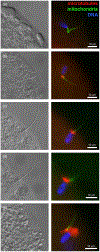Review: Sperm-oocyte interactions and their implications for bull fertility, with emphasis on the ubiquitin-proteasome system
- PMID: 29477154
- PMCID: PMC6503950
- DOI: 10.1017/S1751731118000253
Review: Sperm-oocyte interactions and their implications for bull fertility, with emphasis on the ubiquitin-proteasome system
Abstract
Fertilization is an intricate cascade of events that irreversibly alter the participating male and female gamete and ultimately lead to the union of paternal and maternal genomes in the zygote. Fertilization starts with sperm capacitation within the oviductal sperm reservoir, followed by gamete recognition, sperm-zona pellucida interactions and sperm-oolemma adhesion and fusion, followed by sperm incorporation, oocyte activation, pronuclear development and embryo cleavage. At fertilization, bull spermatozoon loses its acrosome and plasma membrane components and contributes chromosomes, centriole, perinuclear theca proteins and regulatory RNAs to the zygote. While also incorporated in oocyte cytoplasm, structures of the sperm tail, including mitochondrial sheath, axoneme, fibrous sheath and outer dense fibers are degraded and recycled. The ability of some of these sperm contributed components to give rise to functional zygotic structures and properly induce embryonic development may vary between bulls, bearing on their reproductive performance, and on the fitness, health, fertility and production traits of their offspring. Proper functioning, recycling and remodeling of gamete structures at fertilization is aided by the ubiquitin-proteasome system (UPS), the universal substrate-specific protein recycling pathway present in bovine and other mammalian oocytes and spermatozoa. This review is focused on the aspects of UPS relevant to bovine fertilization and bull fertility.
Keywords: acrosome; artificial insemination; fertilization; sperm capacitation; zygote.
Conflict of interest statement
Declaration of interest
There is no conflicts of interest to declare.
Figures



Similar articles
-
Paternal contributions to mammalian zygote - Beyond sperm-oocyte fusion.Curr Top Dev Biol. 2025;162:387-446. doi: 10.1016/bs.ctdb.2025.02.002. Epub 2025 Mar 18. Curr Top Dev Biol. 2025. PMID: 40180516 Review.
-
Paternal contributions to the mammalian zygote: fertilization after sperm-egg fusion.Int Rev Cytol. 2000;195:1-65. doi: 10.1016/s0074-7696(08)62703-5. Int Rev Cytol. 2000. PMID: 10603574 Review.
-
An investigation of the fertilizing characteristics of pyriform-shaped bovine spermatozoa.Anim Reprod Sci. 1999 Oct 31;57(1-2):35-50. doi: 10.1016/s0378-4320(99)00058-5. Anim Reprod Sci. 1999. PMID: 10565438
-
The use of in vitro fertilization techniques to investigate the fertilizing ability of bovine sperm with proximal cytoplasmic droplets.Anim Reprod Sci. 2001 Mar 30;65(3-4):181-92. doi: 10.1016/s0378-4320(00)00231-1. Anim Reprod Sci. 2001. PMID: 11267798
-
Proteasomal interference prevents zona pellucida penetration and fertilization in mammals.Biol Reprod. 2004 Nov;71(5):1625-37. doi: 10.1095/biolreprod.104.032532. Epub 2004 Jul 14. Biol Reprod. 2004. PMID: 15253927
Cited by
-
Heat shock protein family D member 1 in boar spermatozoa is strongly related to the litter size of inseminated sows.J Anim Sci Biotechnol. 2022 Apr 15;13(1):42. doi: 10.1186/s40104-022-00689-0. J Anim Sci Biotechnol. 2022. PMID: 35422006 Free PMC article.
-
Bovine oocyte activation with bull or human sperm by conventional ICSI and Piezo-ICSI: Its relationship with PLCɀ activity.Open Vet J. 2024 May;14(5):1191-1198. doi: 10.5455/OVJ.2024.v14.i5.14. Epub 2024 May 31. Open Vet J. 2024. PMID: 38938440 Free PMC article.
-
Mechanisms of axoneme and centriole elimination in Naegleria gruberi.EMBO Rep. 2025 Jan;26(2):385-406. doi: 10.1038/s44319-024-00329-w. Epub 2024 Dec 2. EMBO Rep. 2025. PMID: 39623167 Free PMC article.
-
The requirement of ubiquitin C-terminal hydrolase L1 in mouse ovarian development and fertility†.Biol Reprod. 2022 Aug 9;107(2):500-513. doi: 10.1093/biolre/ioac086. Biol Reprod. 2022. PMID: 35512140 Free PMC article.
-
Advances in Molecular Biology and Immunology of Spermatozoa and Fertilization in Domestic Animals: Implications for Infertility and Assisted Reproduction.Curr Mol Med. 2025;25(2):167-186. doi: 10.2174/0115665240306965240802075331. Curr Mol Med. 2025. PMID: 39572916 Review.
References
-
- Adamkova K, Yi YJ, Petr J, Zalmanova T, Hoskova K, Jelinkova P, Moravec J, Kralickova M, Sutovsky M, Sutovsky P and Nevoral J 2017. SIRT1-dependent modulation of methylation and acetylation of histone H3 on lysine 9 (H3K9) in the zygotic pronuclei improves porcine embryo development. Journal of Animal Science and Biotechnology 8, 83. - PMC - PubMed
-
- Adjaye J, Herwig R, Brink TC, Herrmann D, Greber B, Sudheer S, Groth D, Carnwath JW, Lehrach H and Niemann H 2007. Conserved molecular portraits of bovine and human blastocysts as a consequence of the transition from maternal to embryonic control of gene expression. Physiological Genomics 31, 315–327. - PubMed
-
- Aul RB and Oko RJ 2002. The major subacrosomal occupant of bull spermatozoa is a novel histone H2B variant associated with the forming acrosome during spermiogenesis. Developmental Biology 242, 376–387. - PubMed
-
- Baska KM, Manandhar G, Feng D, Agca Y, Tengowski MW, Sutovsky M, Yi YJ and Sutovsky P 2008. Mechanism of extracellular ubiquitination in the mammalian epididymis. Journal of Cellular Physiology 215, 684–696. - PubMed
Publication types
MeSH terms
Substances
Grants and funding
LinkOut - more resources
Full Text Sources
Other Literature Sources

